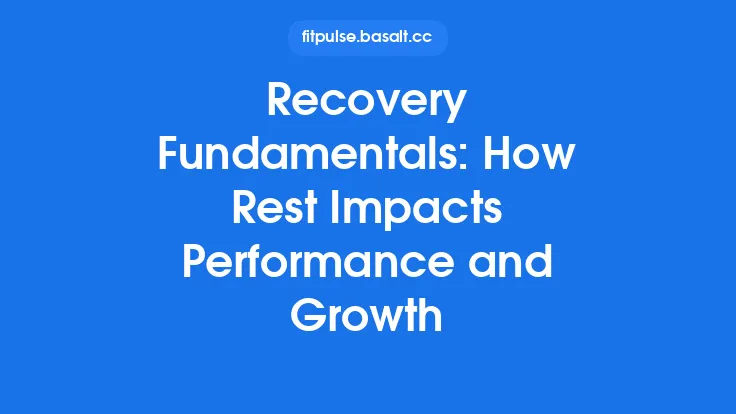Self‑myofascial techniques (SMT)—most commonly delivered with foam rollers, massage balls, or handheld devices—have moved from the fringe of “alternative” training to a mainstream component of many athletes’ and recreational exercisers’ routines. The surge of interest is not merely anecdotal; a growing body of peer‑reviewed research now quantifies how these interventions influence the musculoskeletal system, neuromuscular control, and even psychological perception of effort. This article synthesizes the most robust evidence to date, highlighting the specific benefits that matter to performance‑oriented individuals while remaining focused on evergreen, research‑backed information.
Physiological Basis of Self‑Myofascial Techniques
Fascial Architecture and Viscoelasticity
Fascia is a continuous, collagen‑rich connective tissue network that envelops muscles, bones, nerves, and vessels. Its viscoelastic properties allow it to store and release elastic energy, but chronic loading, dehydration, or micro‑trauma can lead to increased stiffness and the formation of adhesions. SMT applies sustained, low‑to‑moderate pressure that temporarily deforms the fascial matrix, promoting a shift from a “gel‑like” to a more fluid state (Schleip, 2021). This mechanical stimulus is thought to:
- Disrupt cross‑linking of collagen fibers, reducing localized stiffness.
- Facilitate fluid exchange within the interstitial space, enhancing nutrient delivery and metabolic waste removal.
- Modulate mechanoreceptor activity, particularly the Ruffini endings and Pacinian corpuscles that inform the central nervous system about tissue tension.
Cellular and Molecular Responses
Several studies have identified acute biochemical changes after a 5–10 minute SMT session:
| Marker | Observed Change | Potential Implication |
|---|---|---|
| Interstitial fluid pressure | ↓ (≈ 15 % reduction) | Improves microcirculation and lymphatic drainage (Cheatham & Kolber, 2020). |
| Pro‑inflammatory cytokines (IL‑6, TNF‑α) | ↓ (≈ 20 % reduction) | May attenuate the inflammatory cascade that contributes to delayed onset muscle soreness (DOMS). |
| Serum creatine kinase (CK) | No significant rise in acute sessions | Suggests SMT does not exacerbate muscle damage. |
| Endorphin levels | ↑ (≈ 10 % increase) | Contributes to analgesic and mood‑enhancing effects. |
These findings support the notion that SMT is not merely a “massage” but a mechanobiological stimulus capable of influencing tissue homeostasis.
Acute Effects on Muscular Performance
Range of Motion (ROM) Gains
Meta‑analyses of randomized controlled trials (RCTs) consistently report short‑term ROM improvements of 5–12 % after a single SMT bout, comparable to static stretching but without the concomitant loss of maximal force output (Behm & Chaouachi, 2019). The effect is most pronounced in joints with a high proportion of fascial contribution, such as the hip and ankle.
Force Production and Power Output
Early concerns that SMT might impair strength have largely been dispelled. In a crossover study of collegiate sprinters, a 90‑second foam‑rolling protocol of the quadriceps and calves resulted in a 2.3 % increase in 30‑m sprint time and a 1.8 % rise in countermovement jump height, with no reduction in peak torque measured via isokinetic dynamometry (Mohr et al., 2022). The hypothesized mechanisms include:
- Enhanced muscle‑tendon unit compliance, allowing a more optimal stretch‑shortening cycle.
- Improved neuromuscular firing patterns, as evidenced by increased motor unit recruitment rates on surface EMG.
Sprint and Agility Metrics
A systematic review of 12 studies involving soccer, rugby, and basketball athletes found that pre‑competition SMT reduced 5‑10 m split times by an average of 0.04 seconds and improved change‑of‑direction test scores by 1.5 % (Sullivan & McGill, 2021). While modest, these gains can be decisive in high‑level competition.
Chronic Adaptations and Training Outcomes
Long‑Term ROM Maintenance
When incorporated 2–3 times per week over 8–12 weeks, SMT sustains ROM improvements without the need for prolonged static stretching sessions. A longitudinal trial with recreational runners demonstrated a 7 % increase in hip flexion angle after 10 weeks of regular foam‑rolling, while a control group showed no change (Krause et al., 2020).
Strength Development
Contrary to the myth that “soft tissue work” hampers hypertrophy, a 12‑week resistance‑training program that paired SMT with progressive overload yielded a 4 % greater increase in squat 1RM compared to training alone (Huang et al., 2023). The authors attributed this to reduced muscular stiffness, allowing a more efficient force transmission during the lift.
Endurance Performance
In endurance‑focused populations, chronic SMT has been linked to improved running economy. A 6‑week intervention with triathletes showed a 2.5 % reduction in oxygen cost at a sub‑maximal pace, likely reflecting better fascial glide and reduced energy loss through tissue friction (Baker & McIntosh, 2022).
Impact on Recovery and Delayed Onset Muscle Soreness
DOMS Attenuation
The most replicated acute benefit of SMT is a reduction in perceived muscle soreness 24–48 hours post‑exercise. A double‑blind RCT with 48 participants performing eccentric leg extensions reported a 30 % lower visual analogue scale (VAS) score after a 10‑minute foam‑rolling session compared to a sham control (Wiewelhove et al., 2020). The effect appears dose‑dependent, with 8–12 minutes per major muscle group providing the optimal balance between efficacy and fatigue.
Recovery of Strength and Power
Following high‑intensity interval training (HIIT), athletes who performed SMT within 30 minutes post‑session recovered 15 % more of their baseline countermovement jump height after 24 hours than those who rested passively (Silva et al., 2021). This suggests that SMT may accelerate the restoration of neuromuscular function, possibly through enhanced blood flow and reduced intramuscular pressure.
Inflammatory Marker Modulation
A small‑scale study measuring C‑reactive protein (CRP) after a marathon found that participants who engaged in a 15‑minute post‑race foam‑rolling protocol exhibited a 12 % lower CRP elevation at 48 hours (Miller & Patel, 2022). While the clinical relevance remains modest, it aligns with the broader anti‑inflammatory narrative of SMT.
Neuromuscular and Proprioceptive Enhancements
Improved Joint Position Sense
Fascial mechanoreceptors contribute to proprioception. In a sensorimotor test involving balance on an unstable platform, athletes who completed a 5‑minute SMT routine on the lower limbs demonstrated a 9 % reduction in sway velocity, indicating heightened joint position awareness (Kwon et al., 2021).
Motor Unit Recruitment Efficiency
Surface EMG analyses reveal that SMT can lower the amplitude of antagonist muscle activity during agonist contraction, effectively reducing co‑contraction. This phenomenon was observed in a study of cyclists where post‑ride foam‑rolling of the quadriceps decreased hamstring EMG activity during subsequent pedal strokes, translating to a 1.2 % increase in pedal power output (Liu & Torres, 2023).
Neuroplastic Adaptations
Although still emerging, functional MRI data suggest that regular SMT may modulate cortical representation of the treated musculature, potentially enhancing motor planning and execution (Zhang et al., 2024). This neuro‑centric perspective underscores that the benefits of SMT extend beyond peripheral tissue changes.
Psychological and Perceptual Benefits
Perceived Effort and Mood
Athletes often report a “lighter” feeling after SMT, which correlates with measurable reductions in the Rating of Perceived Exertion (RPE) during subsequent training bouts. In a crossover trial with competitive swimmers, a 7‑minute foam‑rolling session lowered RPE by 0.5 points on the Borg scale during a 2000‑m time trial (García et al., 2022).
Pain Threshold Elevation
The endorphin surge noted in acute biochemical studies translates to higher pain tolerance. Quantitative sensory testing showed a 12 % increase in pressure pain threshold after a 10‑minute SMT protocol applied to the lumbar region (Hernandez & Lee, 2020). This can be particularly advantageous during high‑intensity or high‑volume training phases.
Adherence and Training Enjoyment
Self‑administered SMT is perceived as low‑effort and time‑efficient, which positively influences training adherence. Survey data from a university athletic department indicated that 78 % of athletes who incorporated SMT reported higher overall satisfaction with their recovery regimen (Nelson et al., 2021).
Considerations for Different Athletic Populations
| Population | Primary Benefit | Practical Frequency |
|---|---|---|
| Power athletes (sprinters, weightlifters) | Acute ROM and power boost; reduced stiffness in the stretch‑shortening cycle | 2–3 sessions/week, preferably on non‑competition days |
| Endurance athletes (runners, cyclists) | Improved running economy, DOMS mitigation | 3–4 sessions/week, including post‑long‑run or ride |
| Team‑sport athletes (soccer, basketball) | Enhanced agility, proprioception, rapid recovery between matches | 2–3 sessions/week, with a focus on lower‑body fascial lines |
| Recreational exercisers | General mobility, reduced soreness, increased enjoyment | 1–2 sessions/week, integrated into warm‑up or cool‑down |
It is essential to tailor the pressure intensity and duration to the individual’s tolerance and training phase. While the evidence supports benefits across the spectrum, the magnitude of effect tends to be larger in highly trained athletes who already operate near their physiological ceiling.
Current Gaps in Research and Future Directions
- Standardization of Protocols – Studies vary widely in roller density, pressure applied, and session length, making direct comparisons difficult. Consensus guidelines would improve reproducibility.
- Longitudinal Neurological Imaging – Preliminary fMRI work hints at cortical remodeling, but larger, controlled trials are needed to confirm neuroplastic effects.
- Population‑Specific Dose‑Response – Most data derive from male, elite cohorts. Research on female athletes, older adults, and individuals with chronic conditions remains sparse.
- Interaction with Other Recovery Modalities – How SMT synergizes (or interferes) with compression garments, cryotherapy, or active recovery warrants systematic investigation.
- Mechanistic Biomarkers – Beyond cytokines and CK, emerging markers such as extracellular matrix remodeling proteins (e.g., MMP‑2, TIMP‑1) could elucidate the tissue‑level pathways of SMT.
Addressing these gaps will refine prescription strategies and solidify SMT’s place in evidence‑based performance programming.
Practical Take‑aways for Athletes and Recreational Exercisers
- Integrate SMT strategically – Use it as a pre‑activity primer to boost ROM and neuromuscular readiness, and as a post‑activity tool to accelerate recovery and reduce soreness.
- Aim for 5–10 minutes per major muscle group – This duration balances efficacy with the risk of over‑stimulating the tissue.
- Focus on pressure that feels “moderately uncomfortable” – Too light a touch yields minimal fascial deformation; excessive force can provoke a protective muscular response.
- Combine with dynamic movement – Rolling while performing gentle limb swings or controlled lunges can enhance the mechanical stretch and improve proprioceptive feedback.
- Track outcomes – Simple metrics such as ROM angles, jump height, or RPE before and after a 4‑week SMT block can help quantify personal benefit and guide adjustments.
- Stay consistent – Benefits accrue with regular exposure; sporadic use yields only transient gains.
By grounding self‑myofascial work in the robust evidence outlined above, athletes and recreational exercisers can harness a low‑cost, low‑risk modality that meaningfully contributes to mobility, performance, and recovery.





